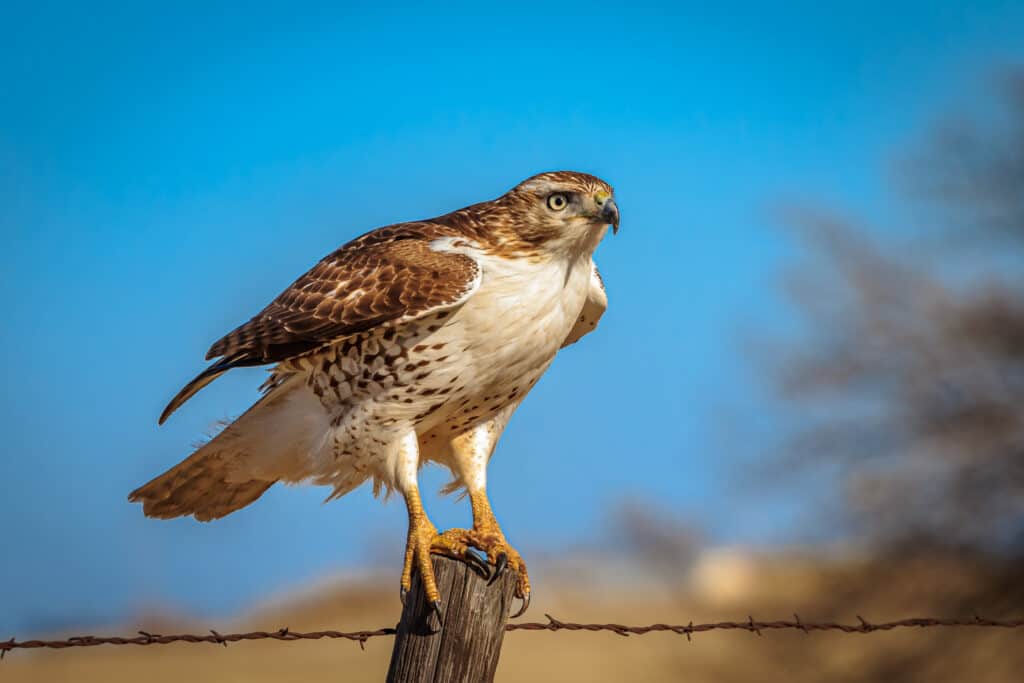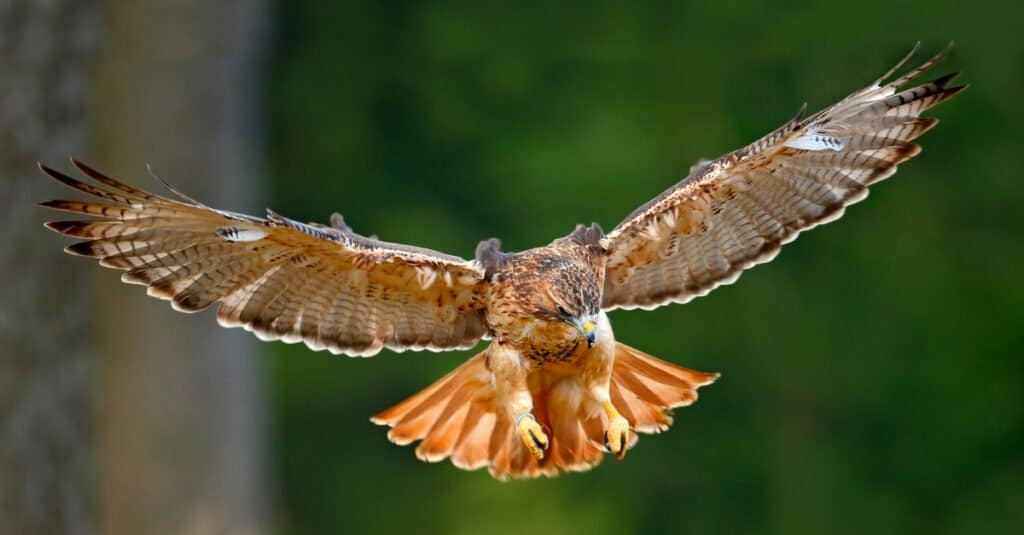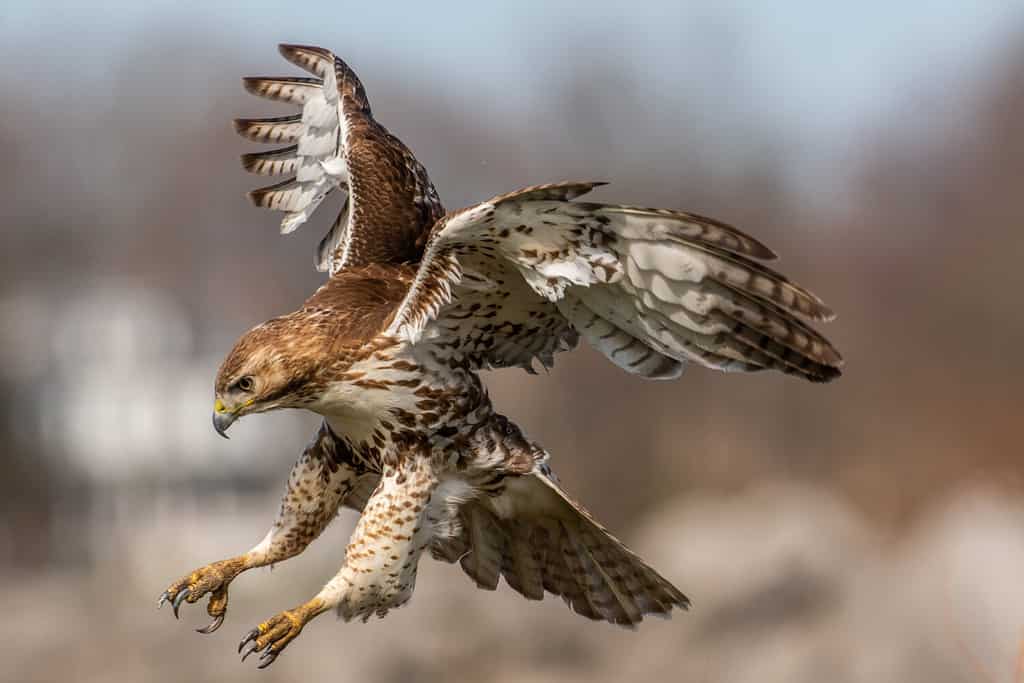How much weight can a hawk carry? The answer varies depending on the type of hawk. Though North America boasts approximately 18 distinct hawk species, we focus on the magnificent red-tailed hawk. As one of the continent’s most widespread and iconic raptors, the red-tailed hawk commands attention with its striking appearance and remarkable hunting prowess. Grab your binoculars, as we set forth to determine how much weight a hawk can carry and three amazing facts about their strength.

As one of the continent’s most widespread and iconic raptors, the red-tailed hawk commands attention.
©Richard G Smith/Shutterstock.com
Red-Tailed Hawk: Size and Appearance
The rusty-red tail of the red-tailed hawk (Buteo jamaicensis) is a defining feature which sets it apart from other hawks. Complementing this fiery accent, its body is varying shades of brown or grayish brown, providing effective camouflage amidst diverse landscapes. The breast area, in contrast, is typically pristine white or light-colored plumage. The red-tailed hawk has a curved beak, ideally adapted for ripping into its prey. In full flight, the red-tailed hawk spreads its impressive wings over four feet (1.2 m). Factors such as age, sex, and regional differences will affect a red-tailed hawk’s weight. Female red-tailed hawks tend to be larger and heavier than males, which is a common characteristic among many bird species. Adult males usually weigh around two to three pounds (1.0 to 1.5 kilograms), while adult females can weigh over three pounds (1.36 kg).

In full flight, the red-tailed hawk spreads its impressive wings over four feet (1.2 m).
©Ondrej Prosicky/Shutterstock.com
How Much Weight Can a Hawk Carry?
Generally speaking, a red-tailed hawk is capable of carrying prey that weighs up to approximately its own body weight, but not significantly more. As a large raptor, the hawk’s strength and flight capabilities allow it to handle relatively heavy prey, such as rabbits or squirrels, which can weigh one to two pounds (0.45 to 1 kg). However, attempting to carry prey that is significantly heavier than its own weight would likely be challenging and impractical for the hawk. The hawk’s powerful talons allow it to capture and transport prey efficiently while conserving energy during flight. By targeting prey that is within a manageable weight range, the red-tailed hawk maximizes its chances of securing a meal and sustaining itself in the wild
3 Amazing Facts About Red-Tailed Hawks’ Strength
Red-tailed hawks showcase their strengths in three distinct ways: physical strength, mental capacity, and visual acuity.
Physical Strength
The red-tailed hawk’s grip strength is an impressive and essential adaption that contributes significantly to its success as a predator. With a grip strength of approximately 200 pounds per square inch (psi), these raptors possess one of the most potent grasping abilities among birds of prey.
The strength of a hawk’s grip is primarily attributed to its powerful talons. They are sharp, curved, and designed for seizing and holding onto prey securely. These talons, combined with the hawk’s well-developed leg muscles, enable it to exert tremendous force when grabbing onto its target.
A grip strength of 200 psi means that a red-tailed hawk can apply pressure of 200 pounds per square inch with each talon. To put this into perspective, the average human grip strength is between 20 to 30 psi. This stark difference illustrates the remarkable power of the hawk’s talons.
Such grip strength allows the red-tailed hawk to effectively capture and immobilize its prey. Once it seizes a target, it can maintain a firm grasp. Even on struggling or relatively heavy animals, such as rabbits or squirrels. This capability ensures that the hawk can subdue and dispatch its prey efficiently, minimizing the risk of escape.

A grip strength of 200 psi means that a red-tailed hawk can apply pressure of 200 pounds per square inch with each talon.
©David Brace/Shutterstock.com
Kiting
Nowhere is the hawk’s physical strength more noticeable than when they are kiting. Kiting is a hunting behavior that involves hovering or soaring in the air at a fixed position. The hawk is typically hovering against the wind while scanning the ground for potential prey. During kiting, the bird maintains a steady position. By using its outstretched wings, it catches the updrafts and thermals generated by the wind. Kiting is an energy-efficient hunting strategy for hawks. The strength to kite comes from the wings of the hawk. The wings play a crucial role in this behavior. They are used to catch and utilize the updrafts and thermals created by the wind to maintain a steady position in the air without flapping.
The design of raptor wings, characterized by their large surface area and broad, rounded tips, allows them to effectively harness the power of wind currents. When the wind hits the wings, it creates lift. Lift helps the bird to remain buoyant and maintain altitude without exerting much energy through wing flapping. The red-tailed hawk’s wings are an adaptation that enables it to kite efficiently. Its wingspan, along with its keen ability to adjust wing positions and use subtle changes in flight feathers, helps the hawk stabilize and control its position during kiting. Hawks can conserve energy by utilizing wind currents to maintain their position in the air while they search for food. The red-tailed hawk’s powerful wings are a crucial asset in executing this technique.

Hawks can conserve energy by utilizing wind currents to maintain their position in the air.
©Daniel Danckwerts/Shutterstock.com
Mental Capacity
Red-tailed hawks are considered intelligent birds. Among raptors, they are known for their problem-solving abilities, adaptability, and complex hunting strategies. Their intelligence is a crucial factor in their success as predators. They use a variety of hunting techniques, including soaring, perching, and kiting, to efficiently locate and capture prey. Red-tailed hawks have been observed learning from experience and adapting their hunting strategies to different prey and environments. They exhibit complex vocalizations and body language, using different calls to communicate with other hawks or warn of potential threats. Red-tailed hawks are highly adaptable and can thrive in both rural and urban environments. They are intelligent in defending and maintaining their territories, using displays and vocalizations to establish boundaries and attract mates.

Red-tailed hawks are highly adaptable and can thrive in both rural and urban environments.
©muratart/Shutterstock.com
Visual Acuity
The red-tailed hawk possesses extraordinary eyesight. This translates to a supreme hunting advantage. Unlike the brute force associated with some predators, the red-tailed hawk’s strength lies in its ability to perceive the world with unparalleled clarity and precision. Its eyesight is tuned to detect even the slightest movements of potential prey, allowing the hawk to spot a mouse scurrying beneath thick undergrowth or a rabbit camouflaged in the surrounding landscape.
Their keen vision enables the red-tailed hawk to patiently observe from a distance, undetected and unhurried until the opportune moment to strike presents itself. It is in this stealthy approach that the hawk exhibits its true strength, as it becomes an expert in the art of patience and strategic hunting. The red-tailed hawk’s remarkable eyesight, like an unseen force guiding its every move, embodies the essence of a true predator, honed through evolution to be an unparalleled master of the hunt.

The red-tailed hawk possesses extraordinary eyesight.
©WildlifeWorld/Shutterstock.com
North American Hawks and the Weight That They Can Carry
| Species | Weight | Load |
|---|---|---|
| Red-tailed hawk (Buteo jamaicensis) | 1.5-3.5 pounds (0.68-1.58 kg) | 1.5-3.5 pounds (0.68-1.58 kg) |
| Cooper’s hawk (Accipiter cooperii) | 1.2 pounds (0.5 kg) | 1.2 pounds (0.5 kg) |
| Broad-winged hawk (Buteo platypterus) | 1 pound (0.45 kg) | 1 pound (0.45 kg) |
| American goshawk (Accipiter atricapillus) | 1.4-3 pounds (0.63-1.36 kg) | 1.4-3 pounds (0.63-1.36 kg) |
| Northern harrier (Circus hudsonius) | 14 ounces (0.4 kg) | 14 ounces (0.4 kg) |
| Harris’s hawk (Parabuteo unicinctus) | 1.5-2.5 pounds (0.68-1.13 kg) | 1.5-2.5 pounds (0.68-1.13 kg) |
| Swainson’s hawk (Buteo swainsoni) | 1.5-3 pounds (0.68-1.36 kg) | 1.5-3 pounds (0.68-1.36 kg) |
| Common black hawk (Buteogallus anthracinus) | 1.8 pounds (0.81 kg) | 1.8 pounds (0.81 kg) |
| Rough legged hawk (Buteo lagopus) | 2.2 pounds (1 kg) | 2.2 pounds (0.99 kg) |
| Sharp-shinned hawk (Accipiter striatus) | 3.0 -7.7 ounces (85 -218 g) | 3.0 -7.7 ounces (85 -218 g) |
| Ferruginous hawk (Buteo regalis) | 3.3 pounds (1.49 kg) | 3.3 pounds (1.49 kg) |
| Great black hawk (Buteogallus urubitinga) | 2.42 pounds (1.1 kg) | 2.42 pounds (1.1 kg) |
| Red-shouldered hawk | 1.3 pounds (0.58 kg) | 1.3 pounds (0.58 kg) |
| Zone-tailed Hawk (Buteo albonotatus) | 1.3-2.1 pounds (0.58-0.95 kg) | 1.3-2.1 pounds (0.58-0.95 kg) |
The photo featured at the top of this post is © scott mirror/Shutterstock.com
Thank you for reading! Have some feedback for us? Contact the AZ Animals editorial team.






